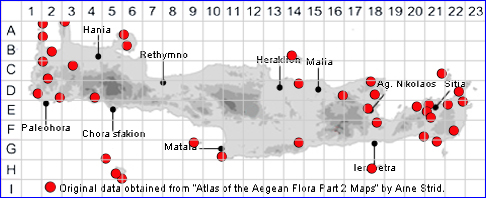
SPECIES DESCRIPTION
CREPIS MULTIFLORA
Family and Genus:- See- COMPOSITAE/Sect. ZACINTHA
Common Names:- None
Homotypic Synonyms:- Barkhausia multiflora, Endoptera multiflora.
Meaning:- Crepis (Gr) A name used by Greek philosopher Theophrastus.
Multiflora (L) Mant-flowered.
General description:- Annual
Stems:-
1) 7-35 cm, branched from the base.
Leaves:-
1) Glabrous.
a) basal, 1-5 x 0·5-1 cm, few, oblanceolate, obtuse, dentate or runcinate-
pinnatifid, attenuate at the base.
b) lower cauline, sessile, amplexicaul, with acute auricles.
c) upper cauline, lanceolate or linear, acute, entire.
Flowers:-
1) Capitula, many.
2) Involucre, 8-9 x 4-6 mm
3) Bracts, linear-lanceolate, acute, the outer glabrous, c. 1/3 as long as the inner.
a) inner bracts, with yellowish glandular hairs.
4) Florets, 7-8 mm.
5) Ligules, yellow.
5) Phyllaries, scarcely swollen and indurate in fruit.
Fruit:-
1) Achenes, dark brown,
2) Of 2 kinds, or marginal absent.
a) marginal, if present 3·5-4 mm, more attenuate above than below, unequally
ribbed.
b) inner, 3-3·5 mm, fusiform, strongly attenuate at the apex, 10-ribbed, strigulose
or finely spinulose near apex.
5) Pappus, exserted from the involucre.
Key features:-
1) Involucre, 8-9 x 4-6 mm.
2) Florets, 7-8 mm.
Habitat:- Coastal areas. dry open shrubby vegetation, cliffs, roadsides and other
dry, open habitats, 0-500(900)m. on various substrates.
Distribution:- Almost restricted to the Aegean area, where it is common and
largely replaces the related C. dioscoridisi just extending to W Anatolia. On Crete
fairly widespread, maily around coastal areas.
Flowering time:- Apr to June.
Photos by:-
